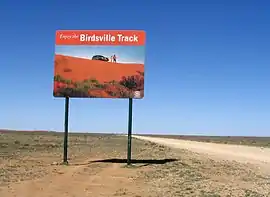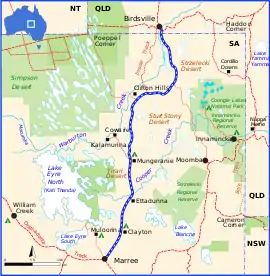Birdsville Track
The Birdsville Track is a notable outback road in Australia. The 517 kilometres (321 mi) track runs between Birdsville in south-western Queensland and Marree, a small town in the north-eastern part of South Australia. It traverses three deserts along the route, the Strzelecki Desert, Sturt Stony Desert and Tirari Desert.
Birdsville Track –Queensland | |
|---|---|
 | |
Sign at the northern end of the Birdsville Track | |
 | |
Birdsville Track route (blue and white) | |
| General information | |
| Type | Track |
| Length | 517 km (321 mi) |
| Major junctions | |
| SW end | Oodnadatta Track, Marree |
| NE end | 25°53′54.08″S 139°21′5.92″E |
| Location(s) | |
| Region | Far North[1] |
| Restrictions | |
| Permits | not required |
| Fuel supply | Mungeranie (28°01′7.28″S 138°39′48.02″E) |
| Facilities | Mungeranie (28°01′7.28″S 138°39′48.02″E) |
Originally the track was of poor quality and suitable for high-clearance four-wheel drive vehicles only, but it is now a graded dirt road and a popular tourist route. It is also used by cattle trucks carrying livestock. The track passes through one of the driest parts of Australia with an average rainfall of less than 100 mm annually.[2] The area is extremely barren, dry and isolated, and travellers should carry water and supplies in case of emergencies.
History
The track was opened in the 1860s to walk cattle from northern Queensland and the Northern Territory to the nearest railhead in Port Augusta which was later moved to Marree. The pioneering drover who is credited with establishing the track was Percy Burt.[2] Burt set up a store at Diamantina Crossing, today known as Birdsville, and used the path to bring cattle out of the Channel Country to the railhead at Marree that was completed in 1883. This stock route was at least 1000 km shorter than the alternative path to Brisbane.[2]
By 1916 enough bores had been sunk into the Great Artesian Basin along the route that the movement of stock was much easier and safer than in earlier years.[2] Bores were drilled at 40km intervals.
An isolated store along the track operated for several decades from the Mulka Station; the Mulka Store Ruins are listed on the South Australian Heritage Register.[3]
Over the years the Birdsville track became one of the country's most isolated and best-known stock routes as well as a mail route made famous by outback legend Tom Kruse. Tom Kruse and the track were immortalised in The Back of Beyond, the 1954 documentary film made by John Heyer. Kruse's services ceased in 1963 to be replaced by an air service from Adelaide that started in 1970.[2]
In 2006, as part of the Year of the Outback, the Australian Governor-General, Michael Jeffery, travelled along the track in a 5-day event.[4]
The route was earmarked to be signed as part National Route 83 in the original plan of National Routes. It was to start in southern SA before travelling north through to far-north QLD. The route was never fully signed, the Birdsville Track being still largely unsealed.[5]
During the COVID-19 pandemic, the track experienced a boost in popularity among drivers taking the route to avoid New South Wales and possible quarantine.[6]
Today
Up until the 1930s only stock and camel trains would take the Birdsville track. Nowadays it has become a very popular track. As a result, the track is reasonably well maintained and generally fairly smooth. However like any outback track, its condition can change, especially after rain. Large stretches of the track can still be destroyed by flash flooding and drifting sand.[2] In dry conditions a shorter route at the northern end depicted on maps as the "Inside track" saves 35 kilometres in distance.[7] Other than this, the road has no major intersections.
Fuel, supplies and facilities, including a hotel, can be found on the track at the Mungeranie station, 204 km from Marree and 313 km from Birdsville.
References
- "Far North SA government region" (PDF). The Government of South Australia. Retrieved 16 August 2015.
- Reardon, Mitch (1995). The Australian Geographic Book of Corner Country. Terrey Hills, New South Wales: Australian Geographic. pp. 141–151. ISBN 1-86276-012-8.
- "Mulka Store (sometime Scobie Homestead) Ruins". South Australian Heritage Register. Department of Environment, Water and Natural Resources. Archived from the original on 15 February 2016. Retrieved 12 February 2016.
- Annabelle Homer (11 March 2006). "Up the Birdsville Track with GG". ABC Rural. Australian Broadcasting Corporation. Retrieved 25 October 2009.
- "Driving the Birdsville Track". Royal Automobile Association of South Australia. 2017. Retrieved 11 November 2017.
- Birdsville Track dubbed ‘COVID highway’ after influx of holiday drivers (news.com.au)
- Hema, Maps (2006). Australia’s Great Desert Tracks SE Sheet (Map). Eight Mile Plains Queensland: Hema Maps. ISBN 978-1-86500-162-3.